< Prev Index Next >
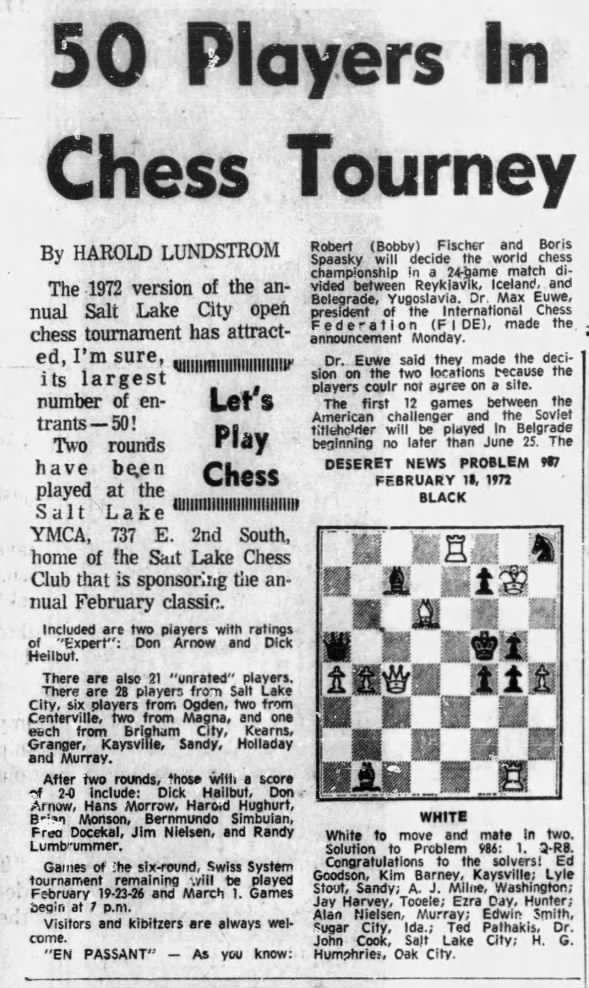 Let's Play Chess Fri, Feb 18, 1972 – 40 · Deseret News (Salt Lake City, Utah) · Newspapers.com
Let's Play Chess Fri, Feb 18, 1972 – 40 · Deseret News (Salt Lake City, Utah) · Newspapers.com
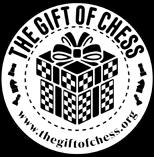
Notice to commercial publishers seeking use of images from this collection of chess-related archive blogs. For use of the many large color restorations, two conditions must be met: 1) It is YOUR responsibility to obtain written permissions for use from the current holders of rights over the original b/w photo. Then, 2) make a tax-deductible donation to The Gift of Chess in honor of Robert J. Fischer-Newspaper Archives. A donation in the amount of $250 USD or greater is requested for images above 2000 pixels and other special request items. For small images, such as for fair use on personal blogs, all credits must remain intact and a donation is still requested but negotiable. Please direct any photographs for restoration and special request (for best results, scanned and submitted at their highest possible resolution), including any additional questions to S. Mooney, at bobbynewspaperblogs•gmail. As highlighted in the ABC News feature, chess has numerous benefits for individuals, including enhancing critical thinking and problem-solving skills, improving concentration and memory, and promoting social interaction and community building. Initiatives like The Gift of Chess have the potential to bring these benefits to a wider audience, particularly in areas where access to educational and recreational resources is limited.
| Best of Chess |
Fischer Newspaper Archives
• Robert J. Fischer, 1955 ➦
• Robert J. Fischer, 1956 ➦ • Robert J. Fischer, 1957 ➦ • Robert J. Fischer, 1958 ➦ • Robert J. Fischer, 1959 ➦ • Robert J. Fischer, 1960 ➦ • Robert J. Fischer, 1961 ➦ • Robert J. Fischer, 1962 ➦ • Robert J. Fischer, 1963 ➦ • Robert J. Fischer, 1964 ➦ • Robert J. Fischer, 1965 ➦ • Robert J. Fischer, 1966 ➦ • Robert J. Fischer, 1967 ➦ • Robert J. Fischer, 1968 ➦ • Robert J. Fischer, 1969 ➦ • Robert J. Fischer, 1970 ➦ • Robert J. Fischer, 1971 ➦ • Robert J. Fischer, 1972 ➦ • Robert J. Fischer, 1973 ➦ • Robert J. Fischer, 1974 ➦ • Robert J. Fischer, 1975 ➦ • Robert J. Fischer, 1976 ➦ • Robert J. Fischer, 1977 ➦ • Robert J. Fischer, 1978 ➦ • Robert J. Fischer, 1979 ➦ • Robert J. Fischer, 1980 ➦ • Robert J. Fischer, 1981 ➦ • Robert J. Fischer, 1982 ➦ • Robert J. Fischer, 1983 ➦ • Robert J. Fischer, 1984 ➦ • Robert J. Fischer, 1985 ➦ • Robert J. Fischer, 1986 ➦ • Robert J. Fischer, 1987 ➦ • Robert J. Fischer, 1988 ➦ • Robert J. Fischer, 1989 ➦ • Robert J. Fischer, 1990 ➦ • Robert J. Fischer, 1991 ➦ • Robert J. Fischer, 1992 ➦ • Robert J. Fischer, 1993 ➦ • Robert J. Fischer, 1994 ➦ • Robert J. Fischer, 1995 ➦ • Robert J. Fischer, 1996 ➦ • Robert J. Fischer, 1997 ➦ • Robert J. Fischer, 1998 ➦ • Robert J. Fischer, 1999 ➦ • Robert J. Fischer, 2000 ➦ • Robert J. Fischer, 2001 ➦ • Robert J. Fischer, 2002 ➦ • Robert J. Fischer, 2003 ➦ • Robert J. Fischer, 2004 ➦ • Robert J. Fischer, 2005 ➦ • Robert J. Fischer, 2006 ➦ • Robert J. Fischer, 2007 ➦ • Robert J. Fischer, 2008 ➦ |
Chess Columns |
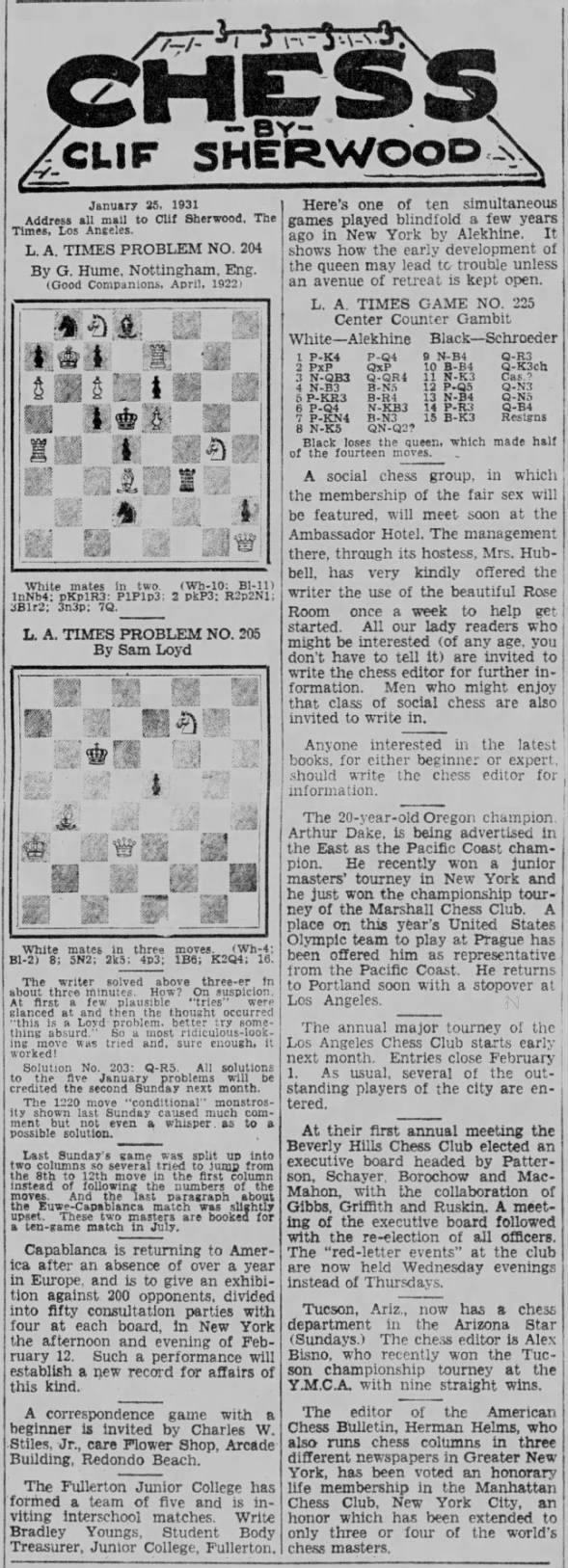 Chess by Clif Sherwood Sun, Jan 25, 1931 – 90 · The Los Angeles Times (Los Angeles, California) · Newspapers.com
Chess by Clif Sherwood Sun, Jan 25, 1931 – 90 · The Los Angeles Times (Los Angeles, California) · Newspapers.com
The Los Angeles Times, Chess by Clif Sherwood Sunday, January 25, 1931 Los Angeles, California L.A. Times Problem No....
Posted by Bobby Fischer's True History on Thursday, December 31, 2020
L.A. Times Problem No. 204 by G. Hume, Nottingham, England. Good Companions, April, 1922. White mates in two.
FEN 1nNb4/pKp1R3/P1P1p3/2pkP3/R2p2N1/3B1r2/3n3p/7Q w - - 0 1
Key: B-B5/Bf5
The Los Angeles Times, Chess by Clif Sherwood Sunday, January 25, 1931 Los Angeles, California L.A. Times Problem No....
Posted by Bobby Fischer's True History on Thursday, December 31, 2020
L.A. Times Problem No. 205 by Sam Loyd. White mates in three moves.
FEN 8/5N2/2k5/4p3/1B6/K2Q4/8/8 w - - 0 1
Key: Q-R7/Qh7 and 2. N-Q6 (1. Nd6 Kb6 2. Qh7 e4 3. Qb7#). Second move not easy to see.
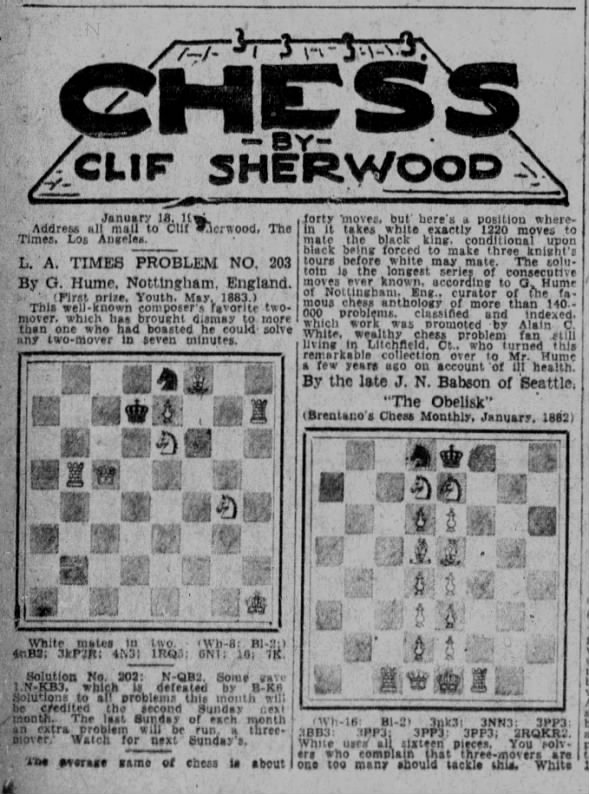 Chess by Clif Sherwood Sun, Jan 18, 1931 – 79 · The Los Angeles Times (Los Angeles, California) · Newspapers.com
Chess by Clif Sherwood Sun, Jan 18, 1931 – 79 · The Los Angeles Times (Los Angeles, California) · Newspapers.com
 Chess by Clif Sherwood (2) Sun, Jan 18, 1931 – 79 · The Los Angeles Times (Los Angeles, California) · Newspapers.com
Chess by Clif Sherwood (2) Sun, Jan 18, 1931 – 79 · The Los Angeles Times (Los Angeles, California) · Newspapers.com
 Chess by Clif Sherwood (3) Sun, Jan 18, 1931 – 79 · The Los Angeles Times (Los Angeles, California) · Newspapers.com
Chess by Clif Sherwood (3) Sun, Jan 18, 1931 – 79 · The Los Angeles Times (Los Angeles, California) · Newspapers.com
The Los Angeles Times, Chess by Clif Sherwood Sunday, January 18, 1931 Los Angeles, California L.A. Times Problem No....
Posted by Bobby Fischer's True History on Thursday, December 31, 2020
L.A. Times Problem No. 203 by G. Hume, Nottingham, England. First prize, Youth, May, 1883. This well-known composer's favorite two-mover, which has brought dismay to more than one who had boasted he could solve any two-mover in seven minutes.
FEN 4nB2/3kP2R/4N3/1RQ5/6N1/8/8/7K w - - 0 1
Key: Q-R5/Qh5
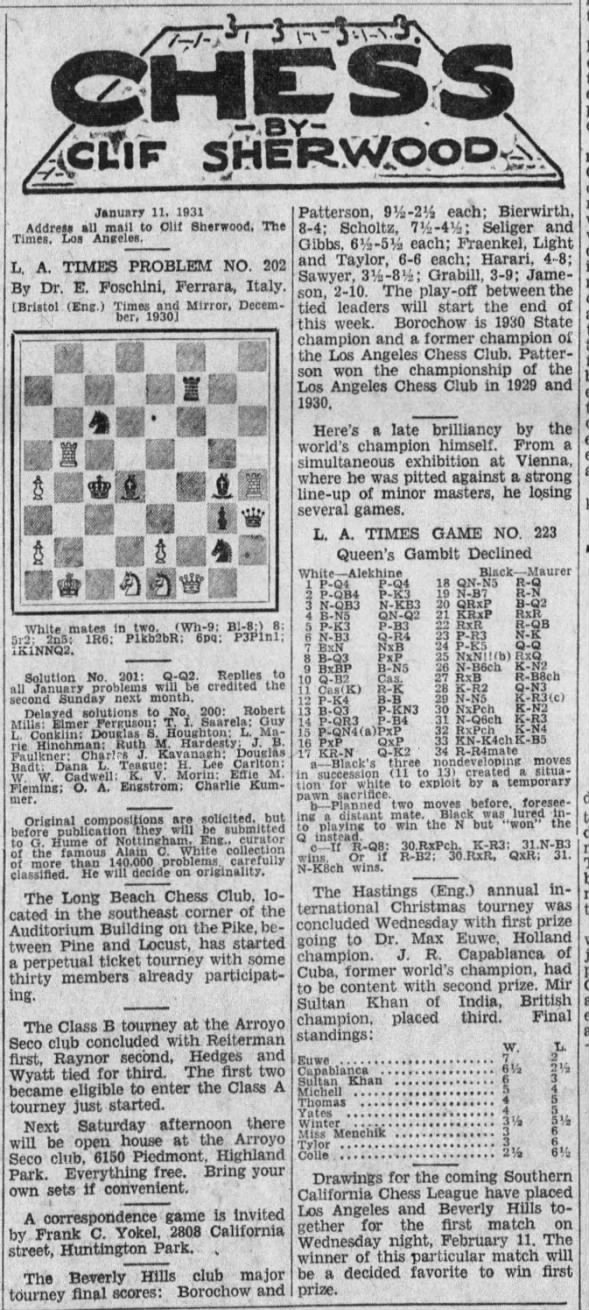 Chess by Clif Sherwood Sun, Jan 11, 1931 – 72 · The Los Angeles Times (Los Angeles, California) · Newspapers.com
Chess by Clif Sherwood Sun, Jan 11, 1931 – 72 · The Los Angeles Times (Los Angeles, California) · Newspapers.com
The Los Angeles Times, Chess by Clif Sherwood Sunday, January 11, 1931 Los Angeles, California L.A. Times Problem No....
Posted by Bobby Fischer's True History on Thursday, December 31, 2020
L.A. Times Problem No. 202 by Dr. E. Foschini, Ferrara, Italy. Bristol, England Times and Mirror, December 1930. White mates in two.
FEN 8/5r2/2n5/1R6/P1kb2bR/6pq/P3P1n1/1K1NNQ2 w - - 0 1
Key: N-QB2/Nc2
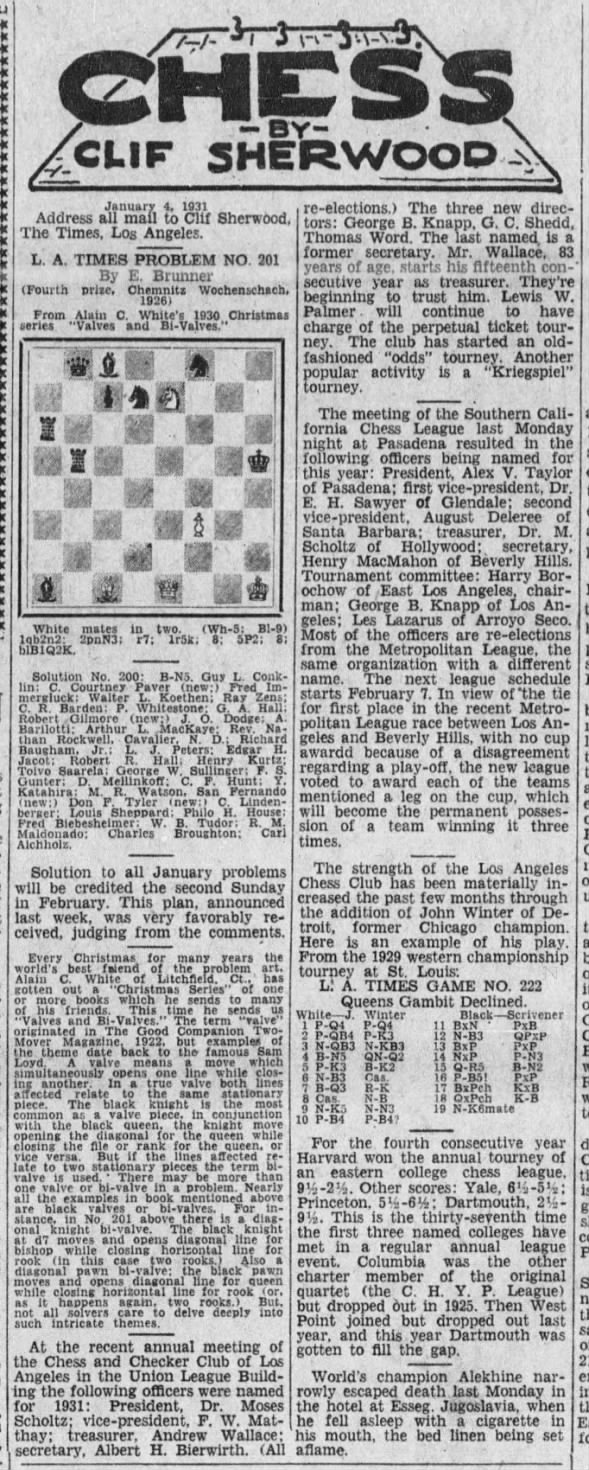 Chess by Clif Sherwood Sun, Jan 4, 1931 – 78 · The Los Angeles Times (Los Angeles, California) · Newspapers.com
Chess by Clif Sherwood Sun, Jan 4, 1931 – 78 · The Los Angeles Times (Los Angeles, California) · Newspapers.com
The Los Angeles Times, Chess by Clif Sherwood Sunday, January 04, 1931 Los Angeles, California L.A. Times Problem No....
Posted by Bobby Fischer's True History on Thursday, December 31, 2020
L.A. Times Problem No. 201 by E. Brunner, Fourth prize, Chemnitz Wochenschach, 1926. From Alain C. White's 1930 Christmas series, ‘Valves and Bi-Valves.’ White mates in two.
FEN 1qb2n2/2pnN3/r7/1r5k/8/5P2/8/b1B1Q2K w - - 0 1
Key: Q-Q2/Qd2
< Prev Index Next >
The Signal Santa Clarita, California Friday, February 18, 1972 - Page 6
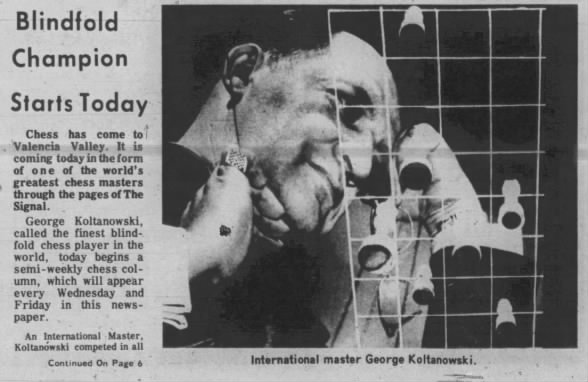 Blindfold Champion Starts Today Fri, Feb 18, 1972 – 1 · The Signal (Santa Clarita, California) · Newspapers.com
Blindfold Champion Starts Today Fri, Feb 18, 1972 – 1 · The Signal (Santa Clarita, California) · Newspapers.com
Blindfold Champion Starts Today
Chess has come to Valencia Valley. It is coming today in the form of one of the world's greatest chess masters through the pages of The Signal.
George Koltanowski, called the finest blindfold chess player in the world, today begins a semi-weekly chess column, which will appear every Wednesday and Friday in this newspaper. An International Master, Koltanowski competed in all …
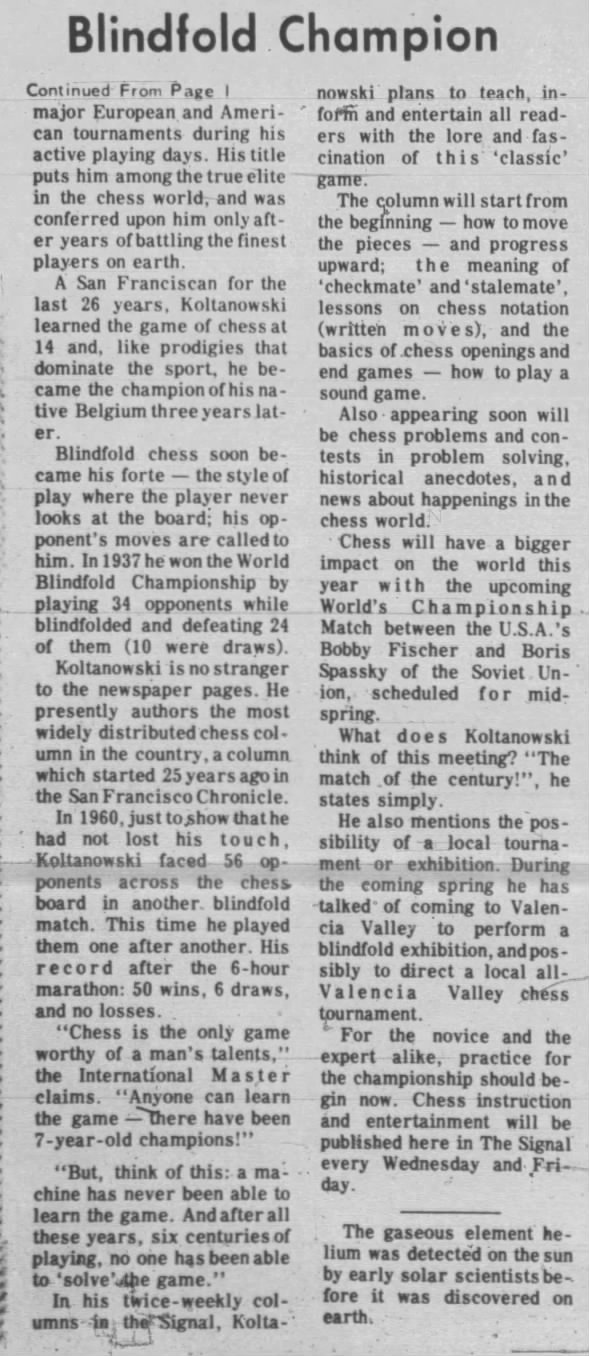 Blindfold Champion Fri, Feb 18, 1972 – 6 · The Signal (Santa Clarita, California) · Newspapers.com
Blindfold Champion Fri, Feb 18, 1972 – 6 · The Signal (Santa Clarita, California) · Newspapers.com
Continued from Page 1
…major European and American tournaments during his active playing days. His title puts him among the true elite in the chess world, and was conferred upon him only after years of battling the finest players on earth.
A San Franciscan for the last 26 years, Koltanowski learned the game of chess at 14 and, like prodigies that dominate the sport, he became the champion of his native Belgium three years later.
Blindfold chess soon became his forte — the style of play where the player never looks at the board; his opponent's moves are called to him. In 1937 he won the World Blindfold Championship by playing 35 opponents while blindfolded and defeating 24 of them (10 were draws).
Koltanowski is no stranger to the newspaper pages. He presently authors the most widely distributed chess column in the country, a column which started 25 years ago in the San Francisco Chronicle.
In 1960, just to show that he had not lost his touch, Koltanowski faced 56 opponents across the chessboard in another blindfold match. This time he played them one after another. His record after the 6-hour marathon; 50 wins, 6 draws and no losses.
“Chess is the only game worthy of a man's talents,” the International Master claims. “Anyone can learn the game — there have been 7-year-old champions!”
“But think of this: a machine has never been able to learn the game. And after all these years, six centuries of playing, no one has been able to ‘solve” the game.”
In his twice-weekly columns in the Signal, Koltanowski plans to teach, inform and entertain all readers with the lore and fascination of this ‘classic’ game.
The column will start from the beginning — how to move the pieces — and progress upward; the meaning of ‘checkmate’ and ‘stalemate’, lessons on chess notation (written moves), and the basics of chess openings and end games — how to play a sound game.
Also appearing soon will be chess problems and contests in problem solving, historical anecdotes, and news about happenings in the chess world.
Chess will have a bigger impact on the world this year with the upcoming World's Championship Match between the U.S.A.'s Bobby Fischer and Boris Spassky of the Soviet Union, scheduled for mid-spring.
What does Koltanowski think of this meeting? “The match of the century!” he states simply.
He also mentions the possibility of a local tournament or exhibition. During the coming spring he has talked of coming to Valencia Valley to perform a blindfold exhibition, and possibly to direct a local all-Valencia Valley chess tournament.
For the novice and the expert alike, practice for the championship should begin now. Chess instruction and entertainment will be published here in The Signal every Wednesday and Friday.
 Chess Fri, Feb 18, 1972 – 6 · The Signal (Santa Clarita, California) · Newspapers.com
Chess Fri, Feb 18, 1972 – 6 · The Signal (Santa Clarita, California) · Newspapers.com
< Prev Index Next >
 Chess by Isaac Kashdan Sun, Feb 13, 1972 – 113 · The Los Angeles Times (Los Angeles, California) · Newspapers.com
Chess by Isaac Kashdan Sun, Feb 13, 1972 – 113 · The Los Angeles Times (Los Angeles, California) · Newspapers.com
Fischer Exhibition
Bobby Fischer went on an exhibition tour of Argentina last November after defeating Tigran Petrosian in their match in Buenos Aires. One of his stops was Tucuman, where the Pan American Team Tournament was taking place.
Fischer appearance created at least as much excitement as the proceedings at the team matches and the accompanying congress.
In the simultaneous exhibition Fischer took on 20 opponents in easy going style, winning 17 games, drawing one and losing two, to Jose Rubinstein and Adolfo Rodriguez. Following is the game with Rubinstein
Robert James Fischer vs Jose Rubinstein
Simul, 20b (1971) (exhibition), Tucuman ARG, Nov-09
Sicilian Defense: Fischer-Sozin Attack. Leonhardt Variation (B88) 0-1
https://www.chessgames.com/perl/chessgame?gid=1044355
1. e4 c5 2. Nf3 d6 3. d4 cxd4 4. Nxd4 Nf6 5. Nc3 Nc6 6. Bc4 e6 7. Bb3 Be7 8. Be3 O-O 9. Qe2 a6 10. O-O-O Qc7 11. g4 Nd7 12. Rhg1 Nc5 13. g5 b5 14. Qh5 b4 15. Nce2 Nxb3+ 16. axb3 Nxd4 17. Nxd4 g6 18. Qh6 e5 19. Nf5 Bxf5 20. exf5 Rfc8 21. Rd2 Bf8 22. Qh4 gxf5 23. f4 a5 24. Rg3 a4 25. Rh3 Bg7 26. Kd1 axb3 27. cxb3 Ra1+ 28. Ke2 Qc1 29. Qf2 e4 30. Rh6 Rc2 0-1
< Prev Index Next >
 Chess Sun, Feb 13, 1972 – 21 · The Bangor Daily News (Bangor, Maine) · Newspapers.com
Chess Sun, Feb 13, 1972 – 21 · The Bangor Daily News (Bangor, Maine) · Newspapers.com
The United States Chess Federation has recently released its latest rating report, a listing of all the active tournament players in the country. To no one's surprise, Bobby Fischer heads the list, but his rating is an astounding 2825 points. A few players who try hard bring up the rear of the list with about 500 points. The rest of us, Grandmaster or Grand patzer, are somewhere between these extremes.
The lowest classification on this scale is Class E, below 1200 points. Then there are divisions every 200 points: D (1200-1399), C (1400-1599), B (1600-1799), and A (1800-1999). Above Class A are Experts and 3 classes of Masters. Naturally, there are fewer and fewer players on each step toward the top.
In general, if players are separated by 200 points on this list, i.e., by about a class, the higher rated player should win about 3 games out of 4 from the lower. Opponents within 100 points of each other are pretty well matched.
Class C is average strength for tournament player, and tournament players are generally a class or two stronger than those who play the game only socially.
[…]
These excellent ratings locally, however, are puny next to Fischer's incredible 2825, which indicates that he could toy with us as we could with a raw beginner. In the history of chess, only three other players, all World Champions, have ever reached even 2700 points. Emmanuel Lasker, Capablanca, and Botvinnik all peaked at about 2730, which means Fischer's current performance is about half a class better than their best!
< Prev Index Next >
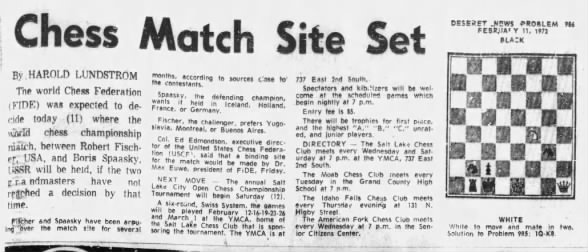 Let's Play Chess Fri, Feb 11, 1972 – 47 · Deseret News (Salt Lake City, Utah) · Newspapers.com
Let's Play Chess Fri, Feb 11, 1972 – 47 · Deseret News (Salt Lake City, Utah) · Newspapers.com
Let's Play Chess: Chess Match Site Set by Harold Lundstrom
The world Chess Federation (FIDE) was expected to decide today (11) where the world chess championship match, between Robert Fischer, USA, and Boris Spassky, USSR will be held, if the two grandmasters have not reached a decision by that time.
Fischer and Spassky have been arguing over the match site for several months to sources close to the contestants.
Spassky, the defending champion, wants it held in Iceland, Holland, France or Germany.
Col. Ed Edmondson, executive director of the United States Chess Federation (USCF), said that a binding site for the match would be made by Dr. Max Euwe, president of FIDE, Friday.
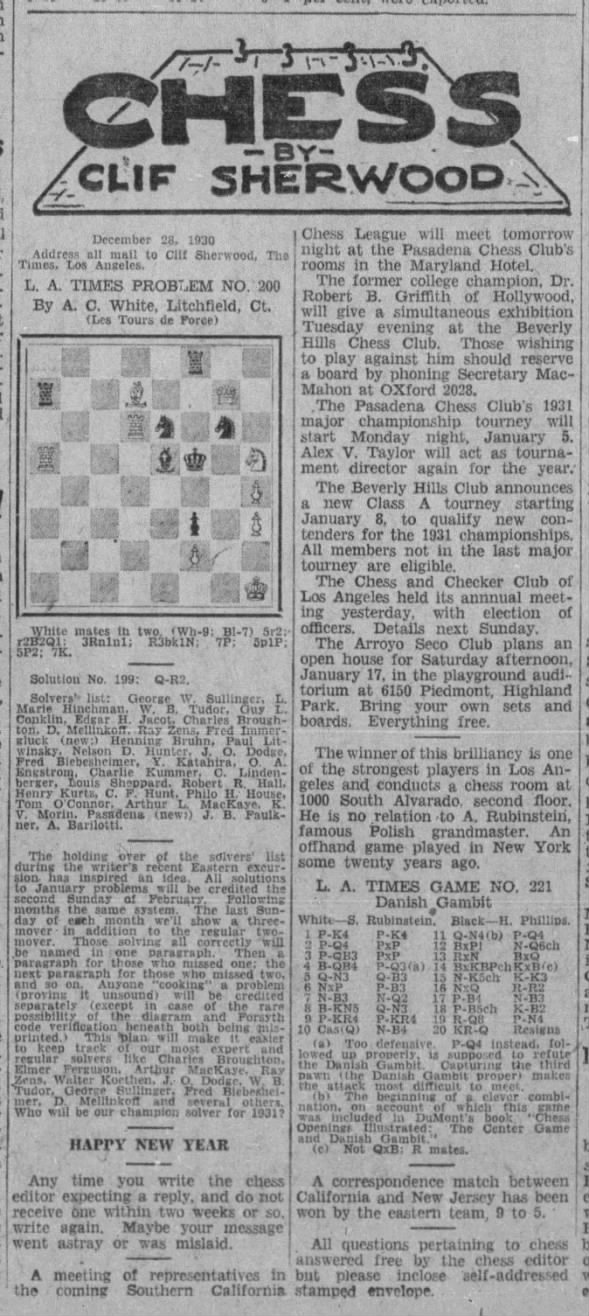 Chess by Clif Sherwood Sun, Dec 28, 1930 – 54 · The Los Angeles Times (Los Angeles, California) · Newspapers.com
Chess by Clif Sherwood Sun, Dec 28, 1930 – 54 · The Los Angeles Times (Los Angeles, California) · Newspapers.com
Chess by Clif Sherwood Sunday, December 28, 1930 The Los Angeles Times Los Angeles, California L.A. Times Problem No....
Posted by Bobby Fischer's True History on Saturday, December 26, 2020
L.A. Times Problem No. 200 by A.C. White, Litchfield, Ct. Les Tours de Force. White mates in two.
FEN 5r2/r2B2Q1/3Rn1n1/R3bk1N/7P/5p1P/5P2/7K w - - 0 1
Key: B-N5/Bb5
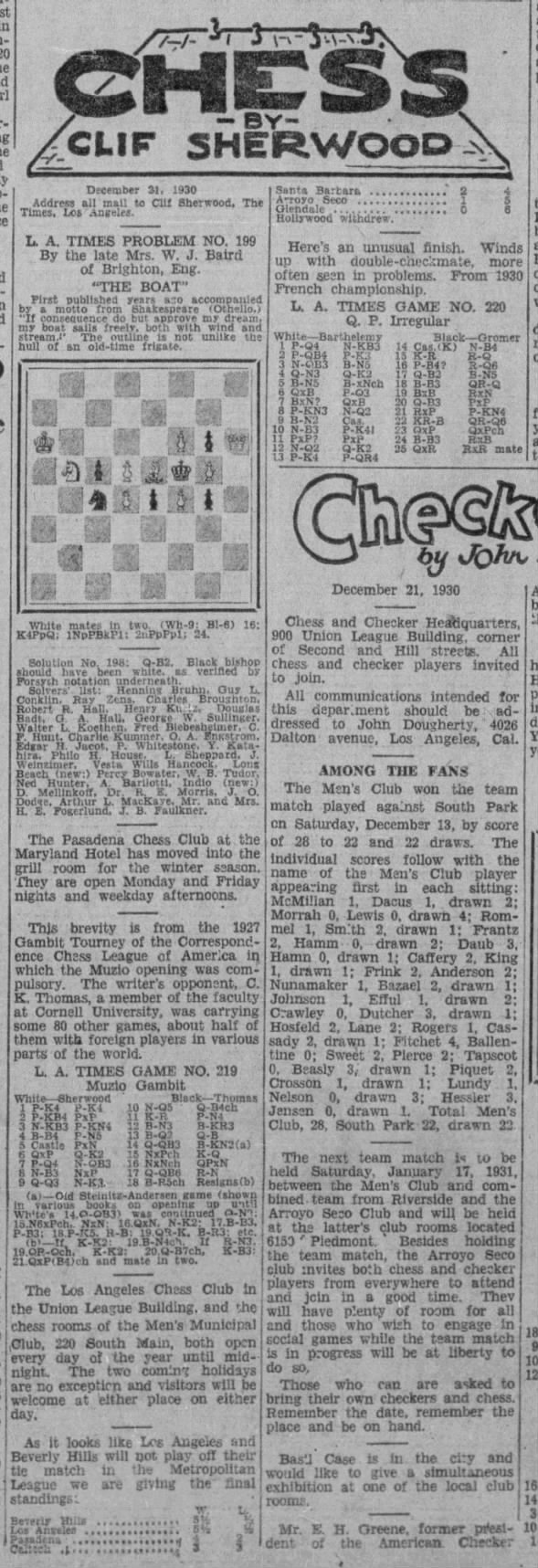 Chess by Clif Sherwood Sun, Dec 21, 1930 – 68 · The Los Angeles Times (Los Angeles, California) · Newspapers.com
Chess by Clif Sherwood Sun, Dec 21, 1930 – 68 · The Los Angeles Times (Los Angeles, California) · Newspapers.com
Chess by Clif Sherwood Sunday, December 21, 1930 The Los Angeles Times Los Angeles, California L.A. Times Problem No....
Posted by Bobby Fischer's True History on Saturday, December 26, 2020
L.A. Times Problem No. 199 by the late Mrs. W.J. Baird of Brighton, England. “The Boat”. First published years ago accompanied by a motto from Shakespeare (Othello,) “If consequence do but approve my dream, my boat sails freely, both with wind and stream.” The outline is not unlike the hull of an old-time frigate.
FEN 8/8/K4PpQ/1NpPBkP1/2nPpPp1/8/8/8 w - - 0 1
Key: Q-R2/Qh2
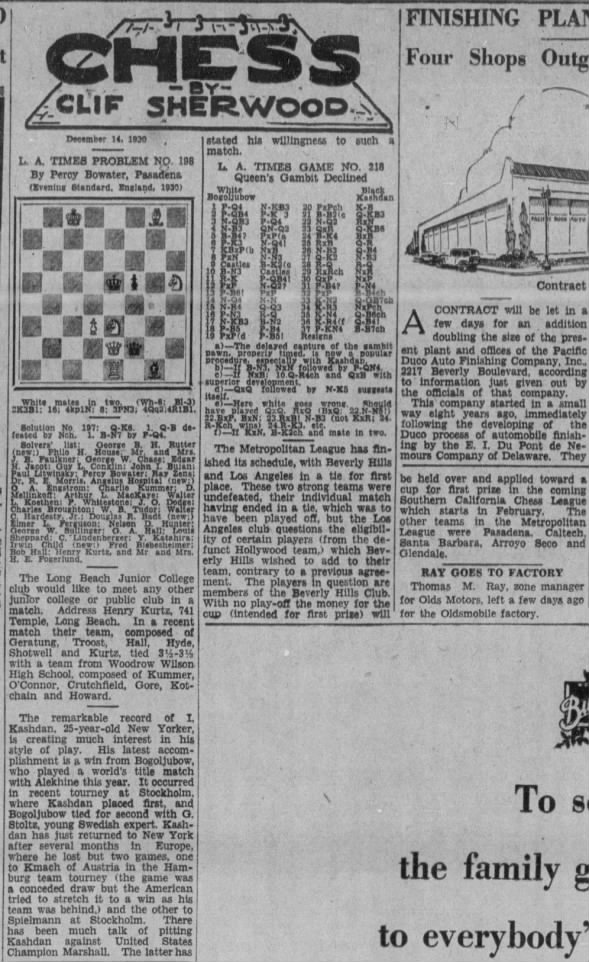 Chess by Clif Sherwood Sun, Dec 14, 1930 – 77 · The Los Angeles Times (Los Angeles, California) · Newspapers.com
Chess by Clif Sherwood Sun, Dec 14, 1930 – 77 · The Los Angeles Times (Los Angeles, California) · Newspapers.com
Chess by Clif Sherwood Sunday, December 14, 1930 The Los Angeles Times Los Angeles, California L.A. Times Problem No....
Posted by Bobby Fischer's True History on Saturday, December 26, 2020
L.A. Times Problem No. 198 by Percy Bowater, Pasadena. Evening Standard, England, 1930. White mates in two.
FEN 2K3B1/8/8/4kp1N/8/3PN3/4Qq2/4R1B1 w - - 0 1
Key: Q-B2/Qc2
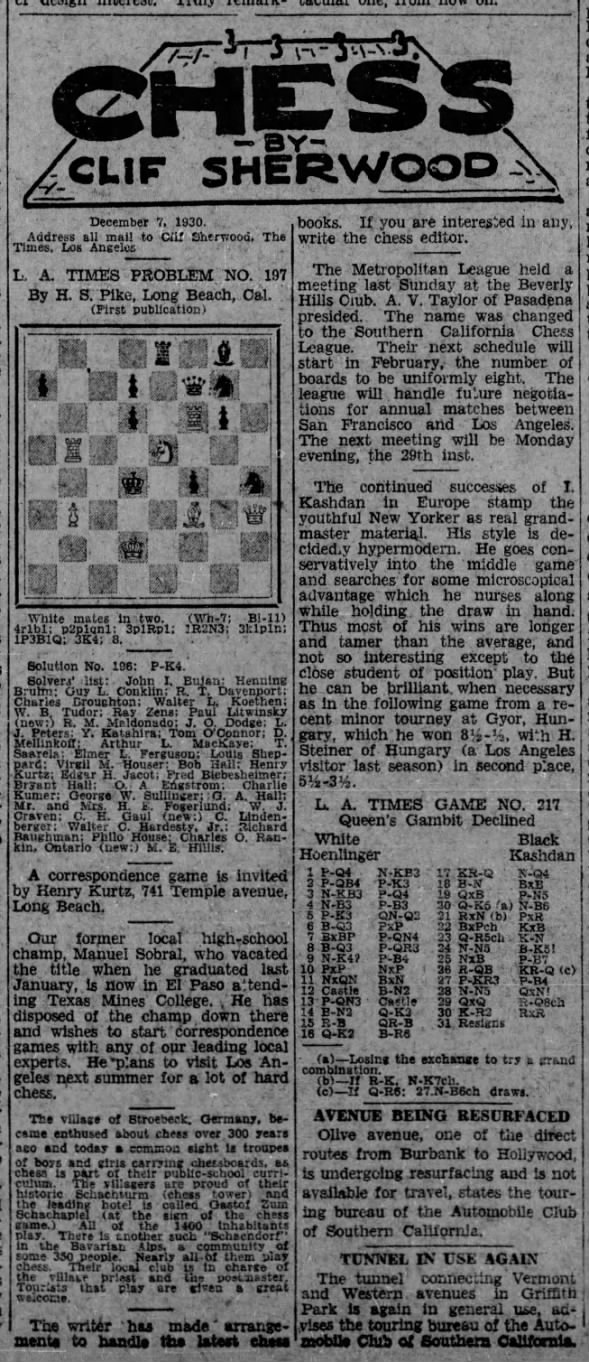 Chess by Clif Sherwood Sun, Dec 7, 1930 – 76 · The Los Angeles Times (Los Angeles, California) · Newspapers.com
Chess by Clif Sherwood Sun, Dec 7, 1930 – 76 · The Los Angeles Times (Los Angeles, California) · Newspapers.com
Chess by Clif Sherwood Sunday, December 07, 1930 The Los Angeles Times Los Angeles, California L.A. Times Problem No....
Posted by Bobby Fischer's True History on Saturday, December 26, 2020
L.A. Times Problem No. 197 by H.S. Pike, Long Beach, California. First publication. White mates in two.
FEN 4r1b1/p2p1qn1/3p1Rp1/1R2N3/3k1p1n/1P3B1Q/3K4/8 w - - 0 1
Key: Q-K6/Qe6
1. Q-B defeated by Nch; 1. B-N7 by P-Q4
< Prev Index Next >
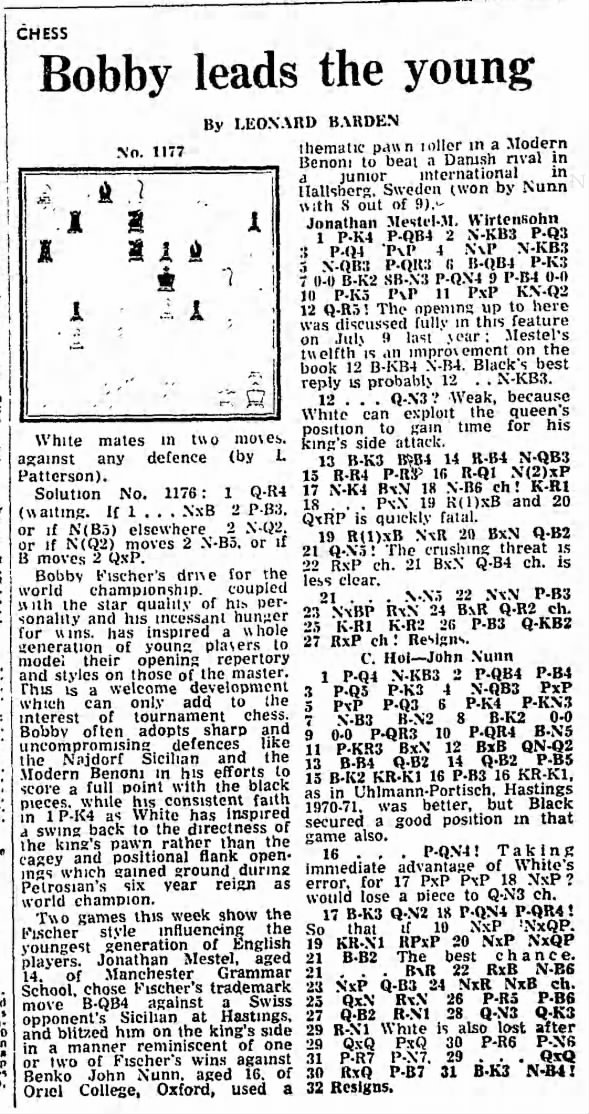 Chess Mon, Feb 7, 1972 – 15 · The Guardian (London, Greater London, England) · Newspapers.com
Chess Mon, Feb 7, 1972 – 15 · The Guardian (London, Greater London, England) · Newspapers.com
Chess: Bobby Leads the Young by Leonard Barden
Bobby Fischer's drive for the world championship, coupled with the star quality of his personality and his incessant hunger for wins, has inspired a whole generation of young players to model their opening repertory and styles on those of the master. This is a welcome development which can only add to the interest of tournament chess. Bobby often adopts sharp and uncompromising defences like the Najdorf Sicilian and the Modern Benoni in his efforts to score a full point with the black pieces, while his consistent faith in 1. P-K4 as White has inspired a swing back to the directness of the king's pawn rather than the cagey and positional flank openings which gained ground during Petrosian's six year reign as world champion.
Two games this week show the Fischer style influencing the youngest generation of English players. Jonathan Mestel, aged 14, of Manchester Grammar School, chose Fischer's trademark move B-QB4 against a Swiss opponent's Sicilian at Hastings, and blitzed him on the king's side in a manner reminiscent of one or two of Fischer's wins against Benko. John Nunn, aged 16, of Oriel College, Oxford, used a thematic pawn roller in a Modern Benoni to beat a Danish rival in a junior international in Hallsberg, Sweden (won by Nunn with 8 out of 9.)
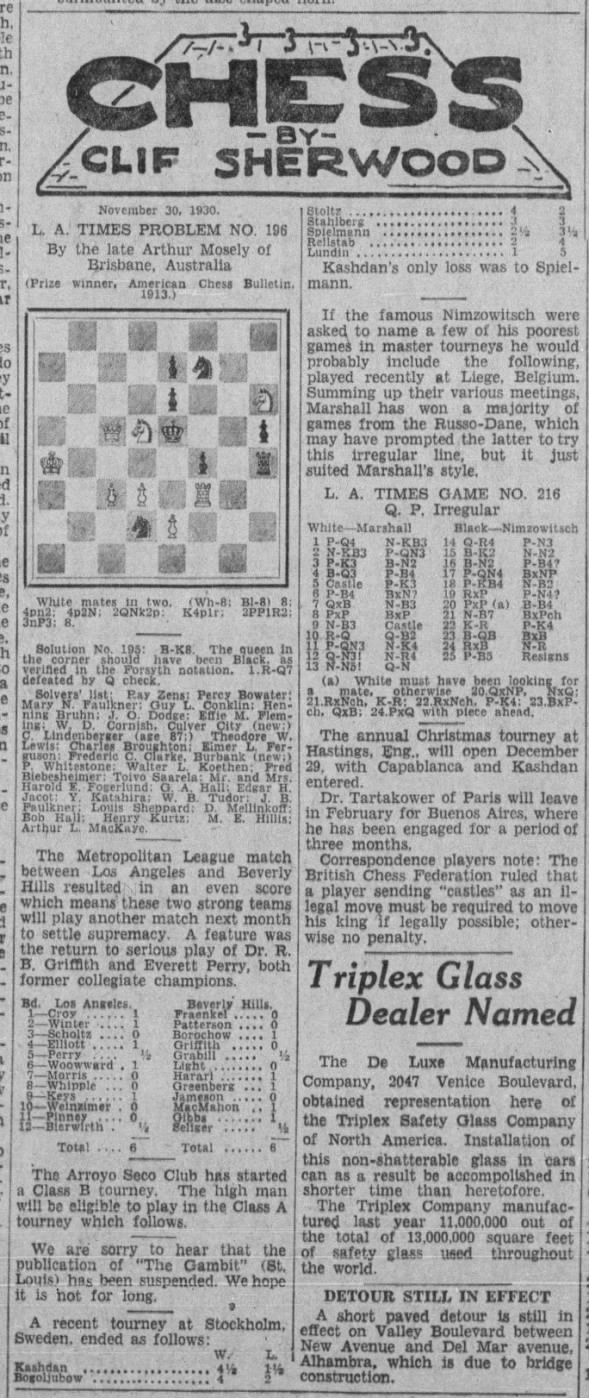 Chess by Clif Sherwood Sun, Nov 30, 1930 – 75 · The Los Angeles Times (Los Angeles, California) · Newspapers.com
Chess by Clif Sherwood Sun, Nov 30, 1930 – 75 · The Los Angeles Times (Los Angeles, California) · Newspapers.com
Chess by Clif Sherwood Sunday, November 30, 1930 The Los Angeles Times Los Angeles, California L.A. Times Problem No....
Posted by Bobby Fischer's True History on Wednesday, December 23, 2020
L.A. Times Problem No. 196 by the late Arthur Mosely of Brisbane, Australia. Prize winner, American Chess Bulletin, 1913. White mates in two.
FEN 8/4pn2/4p2N/2QNk2p/K4p1r/2PP1R2/3nP3/8 w - - 0 1
Key: P-K4/e4
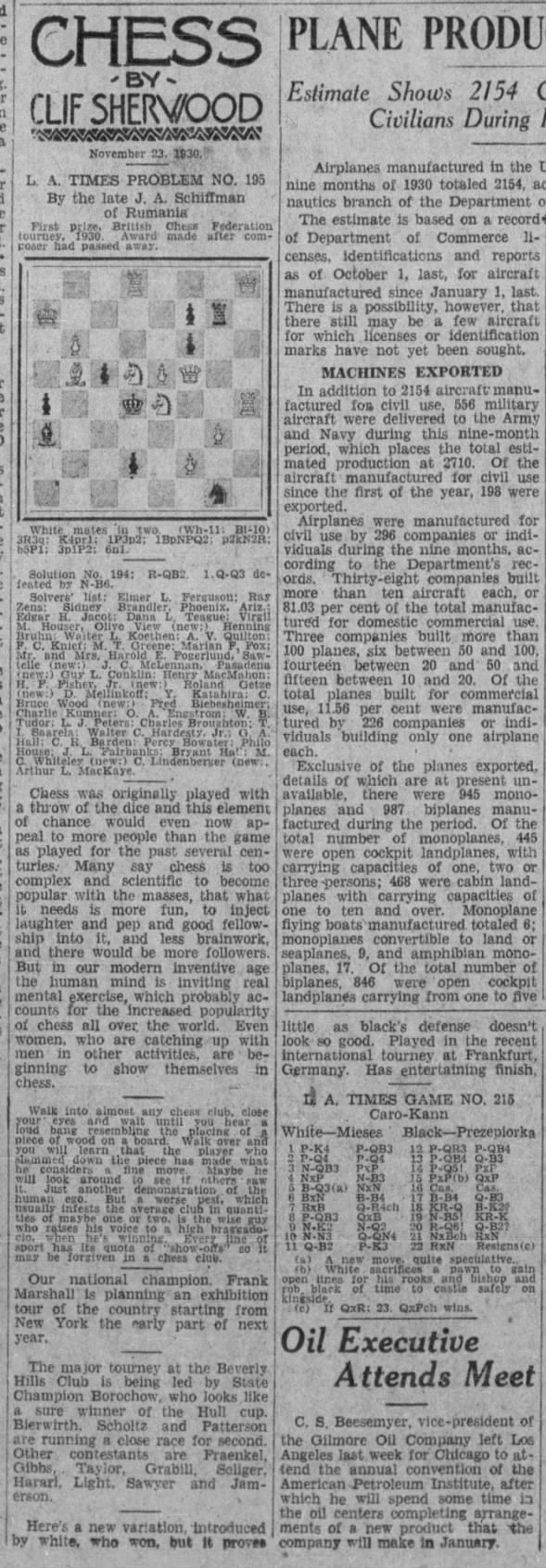 Chess by Clif Sherwood Sun, Nov 23, 1930 – 82 · The Los Angeles Times (Los Angeles, California) · Newspapers.com
Chess by Clif Sherwood Sun, Nov 23, 1930 – 82 · The Los Angeles Times (Los Angeles, California) · Newspapers.com
Chess by Clif Sherwood Sunday, November 23, 1930 The Los Angeles Times Los Angeles, California L.A. Times Problem No....
Posted by Bobby Fischer's True History on Wednesday, December 23, 2020
L.A. Times Problem No. 195 by the late J.A. Schiffman of Rumania. First prize, British Chess Federation tourney, 1930. Award made after composer had passed away. White mates in two.
FEN 3R3q/K4pr1/1P3p2/1BpNPQ2/p2kN2R/b5P1/3p1P2/6n1 w - - 0 1
Key: B-K8/Be8
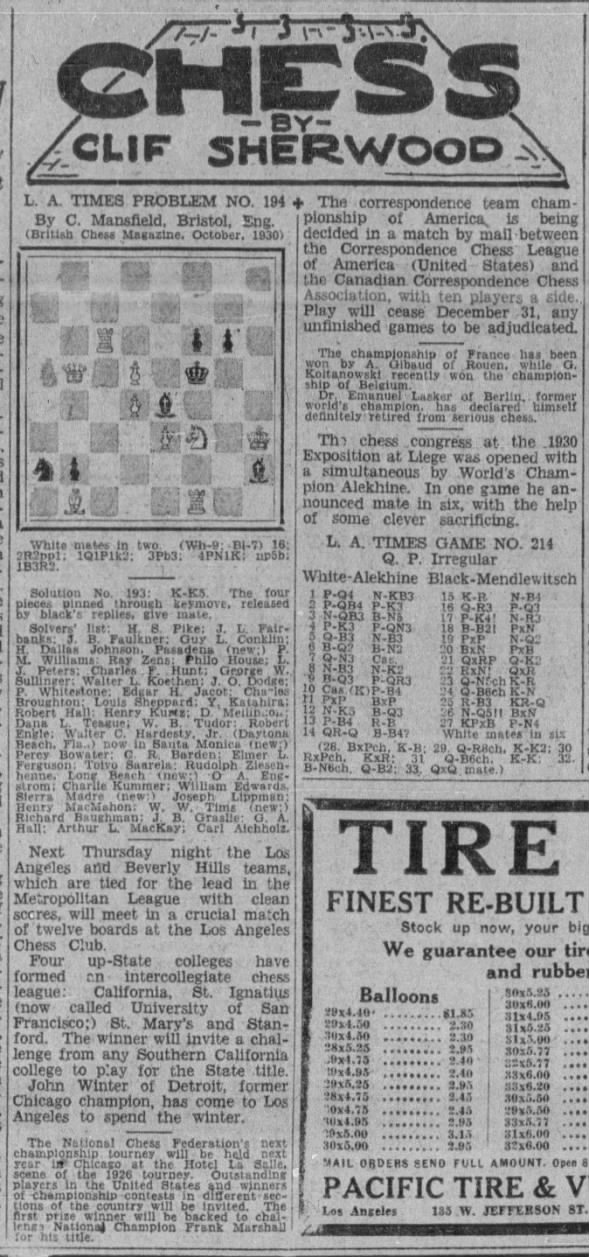 Chess by Clif Sherwood Sun, Nov 16, 1930 – 84 · The Los Angeles Times (Los Angeles, California) · Newspapers.com
Chess by Clif Sherwood Sun, Nov 16, 1930 – 84 · The Los Angeles Times (Los Angeles, California) · Newspapers.com
Chess by Clif Sherwood Sunday, November 16, 1930 The Los Angeles Times Los Angeles, California L.A. Times Problem No....
Posted by Bobby Fischer's True History on Wednesday, December 23, 2020
L.A. Times Problem No. 194 by C. Mansfield, Bristol, England. British Chess Magazine, October, 1930. White mates in two.
FEN 8/8/2R2pp1/1Q1P1k2/3Pb3/4PN1K/np5b/1B3R2 w - - 0 1
Key: R-QB2/Rc2
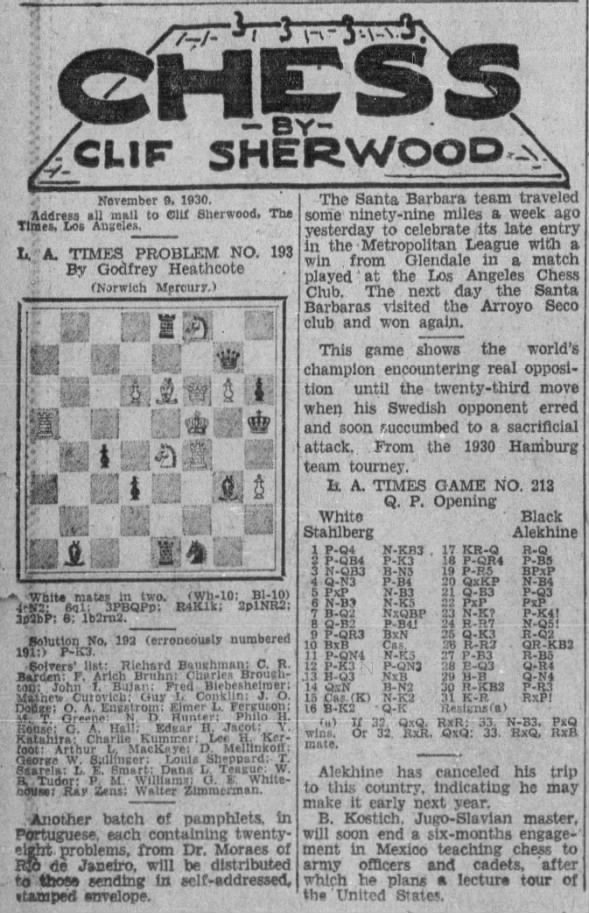 Chess by Clif Sherwood Sun, Nov 9, 1930 – 72 · The Los Angeles Times (Los Angeles, California) · Newspapers.com
Chess by Clif Sherwood Sun, Nov 9, 1930 – 72 · The Los Angeles Times (Los Angeles, California) · Newspapers.com
Chess by Clif Sherwood Sunday, November 09, 1930 The Los Angeles Times Los Angeles, California L.A. Times Problem No....
Posted by Bobby Fischer's True History on Wednesday, December 23, 2020
L.A. Times Problem No. 193 by Godfrey Heathcote. Norwich Mercury. White mates in two.
FEN 4rN2/6q1/3PBQPp/R4K1k/2p1NR2/3p2bP/8/1b2rn2 w - - 0 1
Key: K-K5/Ke5
 Chess by Clif Sherwood Sun, Nov 2, 1930 – 74 · The Los Angeles Times (Los Angeles, California) · Newspapers.com
Chess by Clif Sherwood Sun, Nov 2, 1930 – 74 · The Los Angeles Times (Los Angeles, California) · Newspapers.com
Chess by Clif Sherwood Sunday, November 02, 1930 The Los Angeles Times Los Angeles, California L.A. Times Problem No....
Posted by Bobby Fischer's True History on Wednesday, December 23, 2020
L.A. Times Problem No. 191 by A.C. White, Litchfield, Connecticut. Les Tours de Force. White mates in two.
FEN 2n1Q1BN/3p2p1/1nP1PP1P/2B1k2q/1N3RP1/5P2/4P3/K2R4 w - - 0 1
Key: P-K3/e3
< Prev Index Next >
 Chess by Isaac Kashdan Sun, Feb 6, 1972 – 109 · The Los Angeles Times (Los Angeles, California) · Newspapers.com
Chess by Isaac Kashdan Sun, Feb 6, 1972 – 109 · The Los Angeles Times (Los Angeles, California) · Newspapers.com
Fischer, Spassky Disagree on Match
Bobby Fischer of the U.S. and world chess champion Boris Spassky of the Soviet Union are to play a 24-game match for the title starting some time in June.
This was assured when Fischer defeated former champion Tigran Petrosian, another Soviet grandmaster, in the final of a series of elimination matches.
What is still undetermined is the site of the coming encounter. Each player was asked by Dr. Max Euwe of Holland, president of the International Chess Federation, to submit a list of choices based on bids for the match that were made by 12 different countries.
Fischer's preferences in priority order were Belgrade, Yugoslavia; Sarajevo, Yugoslavia; Buenos Aires, Argentina, and Montreal, Canada. Spassky named Iceland, Holland, W. Germany and France.
Dr. Euwe has the authority to make a final decision, but would much prefer to have the principals negotiate an agreement. Getting nowhere after several long distance calls, he asked Fischer and Spassky to meet with him in Amsterdam. Both agreed to do so.
Fischer flew to Amsterdam last weekend with Lt. Col. Edmund B. Edmondson, executive directory of the U.S. Chess Federation. Spassky did not show. Discussions evidently continued, however. The latest word at this writing is that Fischer flew to Reykjavik, Iceland, for a personal inspection of the playing area proposed.
The Los Angeles Times, Chess by Isaac Kashdan, Los Angeles, California Sunday, February 06, 1972 Times Problem 4111 by...
Posted by Bobby Fischer's True History on Wednesday, December 23, 2020
Times Problem 4111 by T. H. Amirov and J. Hartong. White mates in three.
FEN 8/n2KNR2/p5pr/3Pkn2/5r2/2P3P1/2Q4b/1B5b w - - 0 1
Key: Q-QN2/Qb2
Threat, 2. Q-N8ch; if R-B5, 2. NxPch; if R-QN5 or P-N4, 2. RxNch; if N-Q3, 2. PxRch; if R-R1 or NxN or QN any, 2. P-B4ch.
New Pan-American Team Tournament
For a number of years efforts were made to improve the organization of chess in the Americas. The thought was to create more contacts between the active centers in North America and those in Argentina, Brazil and other countries in South and Central America.
The first real success was achieved last year during the meetings of the International Chess Federation in Vancouver. A charter was drawn up for a Pan-American Chess Association. Fred Cramer of Milwaukee, former president of the U.S. Chess Federation and vice-president of the International body, was on of the prime movers.
The opening congress of the new association was held in Tucuman, Argentina, shortly after the Fischer-Petrosian match, when chess interest in the area was at its height.
Representatives of 11 countries were present. Dr. Max Euwe of Holland, president of the world federation, addressed the opening meeting, and heartily endorsed the aims of the new association.
THe major event at Tucuman was the first Pan-American Team Championship. With insufficient publicity, there were only eight teams, which played a round-robin tournament, with four men on a side in each match.
The Argentines proved much too strong for the opposition, winning every match for a total of 25½ points of a possible 28. On the team were grandmasters Najdorf and Panno, and international masters Sanguinetti, Quinteros and Schweber.
Cuba finished in second place with 17½ points, despite a 4-0 loss to Argentina and a 2½-1½ loss to Brazil. The Cubans won their other five matches.
Brazil and Chile tied for third with 16 points. The other final standings were Paraguay, 11½; Uruguay, 9½; Ecuador, 8½ and Bolivia 7½.
It was decided that the Pan-American Chess Association would meet annually in different countries. An individual championship would alternate with a team event. The program set for the near future is: Pan-American Individual Championship in San Antonio, Texas later this year; second team championship, Cuba, 1973; second individual championship, Canada, 1974, and third team championship, Chile, 1975.
The following game is from the team tournament:
Rodriguez, Cuba (White) vs. Quinteros, Argentina (Black)
English Opening
Descriptive 1. P-QB4 P-K4 2. N-QB3 P-Q3 3. N-B3 P-KN3 4. P-KN3 B-N2 5. B-N2 N-K2 6. O-O O-O 7. P-Q3 P-QB3 8. B-Q2 P-Q4 9. PxP PxP 10. R-B1 QN-B3 11. P-QR3 R-N1 12. N-QR4 P-KR3 13. P-QN4 P-R3 14. N-B5 P-N3 15. N-N3 R-N2 16. P-K3 Q-Q3 17. Q-B2 B-Q2 18. KR-Q1 R-B1 19. Q-N1 QR-B2 20. P-K4 P-Q5 21. B-K1 N-R2 22. KN-Q2 B-R5 23. RxR RxR 24. N-B4 Q-K3 25. R-Q2 N-N4 26. Q-N2 N-Q3 27. B-B1 N/K-B1 28. R-B2 BxN 29. QxB P-QN4 30. B-R3 P-B4 31. PxP PxP 32. BxP NxB 0-1 |
Algebraic 1. c4 e5 2. Nc3 d6 3. Nf3 g6 4. g3 Bg7 5. Bg2 Ne7 6. 0-0 0-0 7. d3 c6 8. Bd2 d5 9. cxd5 cxd5 10. Rc1 Nbc6 11. a3 Rb8 12. Na4 h6 13. b4 a6 14. Nc5 b6 15. Nb3 Rb7 16. e3 Qd6 17. Qc2 Bd7 18. Rd1 Rc8 19. Qb1 Rc7 20. e4 d4 21. Be1 Na7 22. Nd2 Ba4 23. Rxc7 Rxc7 24. Nc4 Qe6 25. Rd2 Nb5 26. Qb2 Nd6 27. Bf1 Nc8 28. Rc2 Bxb3 29. Qxb3 b5 30. Bh3 f5 31. exf5 gxf5 32. Bxf5 Nxf5 0-1 |
< Prev Index Next >
 Chess Master Sat, Feb 5, 1972 – 44 · Times Colonist (Victoria, British Columbia, Canada) · Newspapers.com
Chess Master Sat, Feb 5, 1972 – 44 · Times Colonist (Victoria, British Columbia, Canada) · Newspapers.com
Manhattan Blitz
As the time approaches for the great World Champion match between Bobby Fischer and Boris Spassky, more and more chess addicts are going to be studying Bobby's stylish play. Here are two recent examples of Fischer technique.
< Prev Index Next >
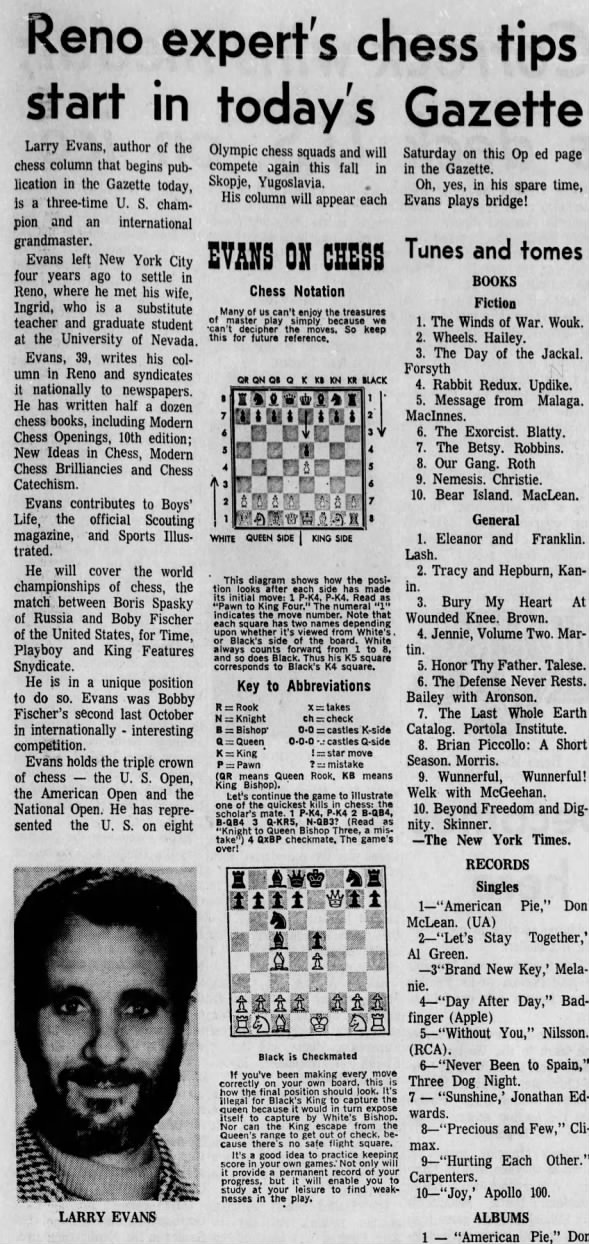 Reno Expert's Chess Tips Start in Today's Gazette Sat, Feb 5, 1972 – Page 5 · Reno Gazette-Journal (Reno, Nevada) · Newspapers.com
Reno Expert's Chess Tips Start in Today's Gazette Sat, Feb 5, 1972 – Page 5 · Reno Gazette-Journal (Reno, Nevada) · Newspapers.com
Reno expert's chess tips start in today's Gazette
Larry Evans, author of the chess column that begins publication in the Gazette today, is a three-time U.S. champion and an international grandmaster. Evans left New York City four years ago to settle in Reno, where he net his wife, Ingrid, who is a substitute teacher and graduate student at the University of Nevada. Evans, 39, writes his column in Reno and syndicates it nationally to newspapers. He has written half a dozen chess books, including Modern Chess Openings, 10th edition; New Ideas in Chess, Modern Chess Brilliancies and Chess Catechism. Evans contributes to Boys' Life, the official Scouting magazine, and Sports Illustrated. He will cover the world championships of chess, the match between Boris Spassky of Russia and Bobby Fischer of the United States, for Time, Playboy and King Features Syndicate. He is in a unique position to do so. Evans was Bobby Fischer's second last October in internationally - interesting competition. Evans holds the triple crown of chess — the U. S. Open, the American Open and the National Open. He has represented the U. S. on eight Olympic chess squads and will compete again this fall in Skopje, Yugoslavia. His column will appear each Saturday on this Op ed page in the Gazette. Oh, yes, in his spare time, Evans plays bridge!
< Prev Index Next >
 Let's Play Chess Fri, Feb 4, 1972 – 16 · Deseret News (Salt Lake City, Utah) · Newspapers.com
Let's Play Chess Fri, Feb 4, 1972 – 16 · Deseret News (Salt Lake City, Utah) · Newspapers.com
Let's Play Chess: Chess Match Dates Not Set by Harold Lundstrom
Robert (Bobby) Fischer, the American chess ace, has gone to Amsterdam for talks concerning the date and site of the world chess title match he will play later this year with world champion, Boris Spassky, of the USSR.
Bobby was met at the Amsterdam airport by Dr. Max Euwe, president of the International Chess Federation (FIDE). Dr. Euwe was world chess champion from 1935 to 1937.
Fischer is accompanied by Ed Edmondson, his manager, and executive director of the USCF, Edmondson once played in a Utah State Tournament.
Dr. Euwe has reported that Spassky had submitted a list of four cities where he wanted to play.
Fischer has listed only two possible sites, and neither of these were on Spassky's list.
Dr. Euwe said he expected Fischer to name two more cities that were agreeable to him, and he hoped one of these would be on Spassky's list.
He did not say which cities were listed on the two lists.
Bobby has said that he would prefer to play in the city that offered the biggest amount of prize money. Spassky has also said he would strongly take into account the climate of the site.
Since the original bids were made, one of the clubs on the Las Vegas “strip” has offered $175,000 in prize money for the match.
< Prev Index Next >
 Chess Sun, Jan 30, 1972 – 40 · The Boston Globe (Boston, Massachusetts) · Newspapers.com
Chess Sun, Jan 30, 1972 – 40 · The Boston Globe (Boston, Massachusetts) · Newspapers.com
“Lubomir Kavalek … However, he must wait five years for naturalization unless Congress helps him. His countryman Pachman was beaten savagely as a political prisoner in Czechoslovakia, spent seven months recuperating in a hospital and now has been rearrested.
Kavalek is a mild and extremely courteous man who decline to make chess his sole livelihood or interest. When asked about Spassky-Fischer, he picked Fischer by about three points, characterizing Spassky's style as leaning heavily toward safety. […] We have heard that the game from the Peters-Murphy match, won 5½-4½ by Peters, will be published in booklet form. Here is one game in which Peters fortifies Fischer's low opinion of black's chances against the Yugoslav attack.
< Prev Index Next >
 Chess Master Sat, Jan 29, 1972 – 6 · Times Colonist (Victoria, British Columbia, Canada) · Newspapers.com
Chess Master Sat, Jan 29, 1972 – 6 · Times Colonist (Victoria, British Columbia, Canada) · Newspapers.com
Chickens and Chess
It is almost a year away, yet chess fans should be alerted to what promises to be the greatest chess tournament ever held in these United States. It will last nearly a month, from November 18 to December 13, and will be held in the San Antonio, Texas, Fair Grounds.
In Europe, it has been commonplace for large business concerns to sponsor chess events. There are, for example, Amsterdam's IBM International and other tournaments sponsored by Naturel, a big Swiss transport firm, and by Schweppes, International.
Up until now, it has been a different story in the U.S. where sponsors scramble for the chance to back football games, auto races, boxing matches — but would not put out a penny for chess. But things have changed, George William Church, Jr., president of Church's Fried Chicken and once sponsor of the San Antonio Open Golf Tournament, has entered the world of chess and has planned a spectacular match which should draw the very best players in the world. There will be $15,000 in prize money, and 18 major masters, most of whom have already accepted, will receive both travel and living allowances.
It is already almost certain that this San Antonio Tournament will receive the greatest press and TV coverage ever accorded chess in the United States. Boris Spassky, presently the World Champion, has said he wants to attend. Such other Grandmasters as Russia's Petrosian, Czechoslovakia's Hort, Yugoslavia's Gligoric, Hungary's Portisch, Brazil's Mecking, Australia's Browne, Denmark's Larsen, the U.S.'s Kavalek and Evans, all plan to be on deck.
Bobby Fischer who, by that time, may very well be the World's Champion, is expected there, too. George Church's timing cannot be faulted.
I expect to be there both as a reporter and as one of the tournament directors.
< Prev Index Next >
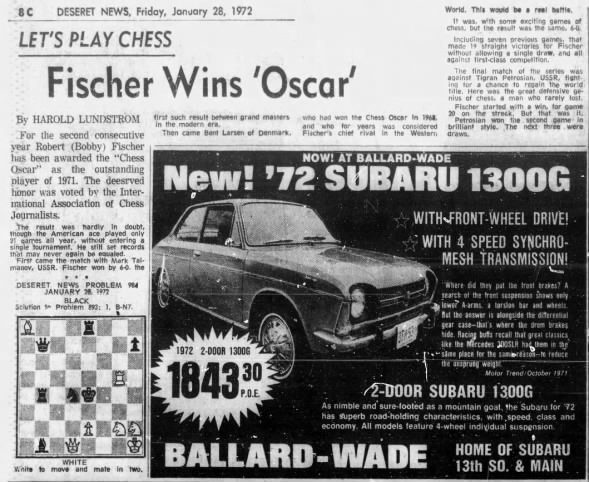 Let's Play Chess Fri, Jan 28, 1972 – 40 · Deseret News (Salt Lake City, Utah) · Newspapers.com
Let's Play Chess Fri, Jan 28, 1972 – 40 · Deseret News (Salt Lake City, Utah) · Newspapers.com
Let's Play Chess: Fischer Wins ‘Oscar’ by Harold Lundstrom
For the second consecutive year Robert (Bobby) Fischer has been awarded the “Chess Oscar” as the outstanding player of 1971. The deserved honor was voted by the International Association of Chess Journalists.
The result was hardly in doubt though the American ace played only 21 games all year, without entering a single tournament. He still set records that may never again be equaled.
First came the match with Mark Taimanov, USSR. Fischer won by 6-0, the first such result between grand masters in the modern era.
Then came Bent Larsen of Denmark, who had won the Chess Oscar in 1968, and who for years was considered Fischer's chief rival in the Western World. This would be a real battle.
It was, with some exciting games of chess, but the result was the same, 6-0.
Including seven previous games, that made 19 straight victories for Fischer without allowing a single draw, and all against first-class competition.
The final match of the series was against Tigran Petrosian, USSR, fighting for a chance to regain the world title. Here was the great defensive genius of chess, a man who rarely lost.
Fischer started with a win, for game 20 on the streak. But that was it.
Petrosian won the second game in brilliant style. The next three were draws.
[The final result, Fischer, 6½ to Petrosian's 2½. On to the battle to claim the world title.]
< Prev Index Next >
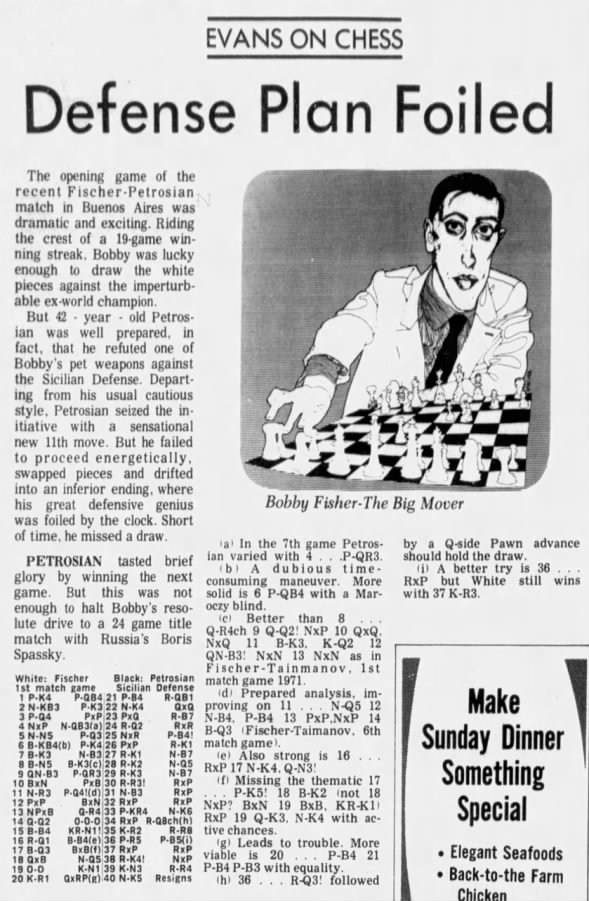 Evans On Chess Sun, Jan 23, 1972 – 101 · Tampa Bay Times (St. Petersburg, Florida) · Newspapers.com
Evans On Chess Sun, Jan 23, 1972 – 101 · Tampa Bay Times (St. Petersburg, Florida) · Newspapers.com
Evans On Chess: Defense Plan Foiled
The opening game of the recent Fischer-Petrosian match in Buenos Aires was dramatic and exciting. Riding the crest of a 19-game winning streak, Bobby was lucky enough to draw the white pieces against the imperturbable ex-world champion.
But 42-year-old Petrosian was well prepared, in fact, that he refuted one of Bobby's pet weapons against the Sicilian Defense. Departing from his usual cautious style, Petrosian seized the initiative with a sensational new 11th move. But he failed to proceed energetically, swapped pieces and drifted into an inferior ending, where his great defensive genius was foiled by the clock. SHort of time, he missed a draw.
PETROSIAN tasted brief glory by winning the next game. But this was not enough to halt Bobby's resolute drive to a 24 game title match with Russia's Boris Spassky.
1. e4 c5 2. Nf3 e6 3. d4 cxd4 4. Nxd4 Nc6(a) 5. Nb5 d6 6. Bf4(b) e5 7. Be3 Nf6 8. Bg5 Be6(c) 9. N1c3 a6 10. Bxf6 gxf6 11. Na3 d5(d) 12. exd5 Bxa3 13. bxa3 Qa5 14. Qd2 O-O-O 15. Bc4 Rhg8! 16. Rd1 Bf5(e) 17. Bd3 Bxd3(f) 18. Qxd3 Nd4 19. O-O Kb8 20. Kh1 Qxa3(g) 21. f4 Rc8 22. Ne4 Qxd3 23. cxd3 Rc2 24. Rd2 Rxd2 25. Nxd2 f5! 26. fxe5 Re8 27. Re1 Nc2 28. Re2 Nd4 29. Re3 Nc2 30. Rh3! Rxe5 31. Nf3 Rxd5 32. Rxh7 Rxd3 33. h4 Ne3 34. Rxf7 Rd1+(h) 35. Kh2 Ra1 36. h5 f4(i) 37. Rxf4 Rxa2 38. Re4! Nxg2 39. Kg3 Ra5 40. Ne5 1-0
Robert James Fischer vs Tigran V Petrosian
Fischer - Petrosian Candidates Final (1971), Buenos Aires ARG, rd 1, Sep-30
Sicilian Defense: Paulsen. Szen Variation (B44) 1-0
https://www.chessgames.com/perl/chessgame?gid=1044350
(a) In the 7th game Petrosian varied with 4 … P-QR3.
(b) A dubious time-consuming maneuver. More solid is 6. P-QB4 with a Maroczy bind.
(c) Better than 8. … Q-R4ch; 9. Q-Q2! NxP; 10. QxQ NxQ; 11. B-K3 K-Q2; 12. QN-B3! NxN; 13. NxN as in Fischer-Taimanov, 1st match game 1971.
(d) Prepared analysis, improving on 11. … N-Q5; 12. N-B4 P-B4; 13. PxP NxP; 14. B-Q3 (Fischer-Taimanov, 6th match game.)
(e) Also strong is 16. … RxP; 17. N-K4 Q-N3
(f) Missing the thematic 17. … P-K5!; 18. B-K2 (not 18. NxP? BxN; 19. BxB KR-K1) RxP 19. Q-K3 N-K4 with active chances.
(g) Leads to trouble. More viable is 20. … P-B4; 21. P-B4 P-B3 with equality.
(h) 36. … R-Q3! followed by a Q-side Pawn advance should hold the draw.
(i) A better try is 36. … RxP but White still wins with 37. K-R3.
< Prev Index Next >
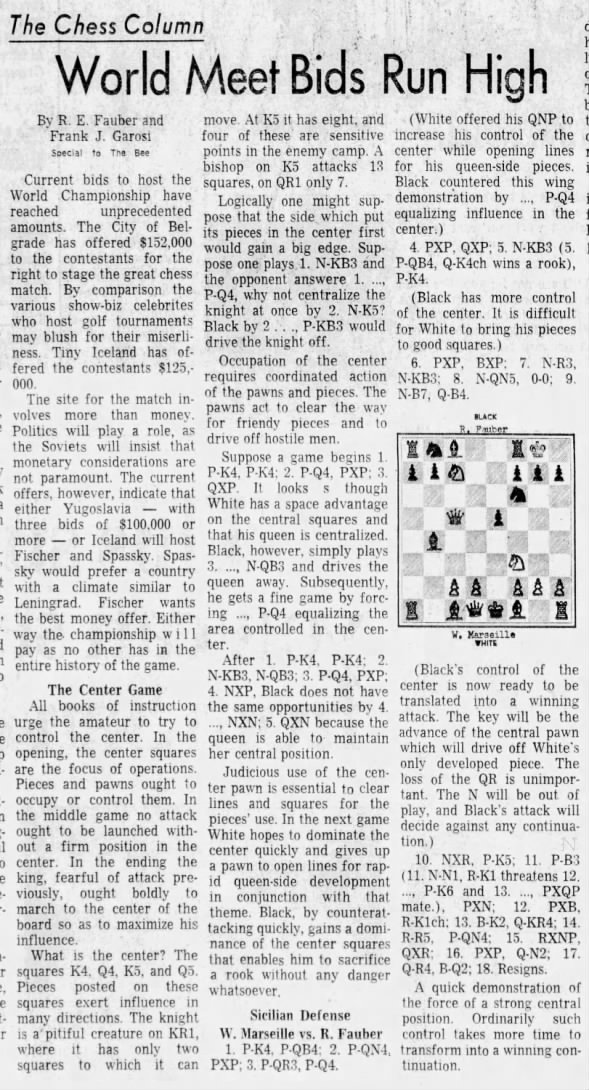 The Chess Column Sun, Jan 23, 1972 – 76 · The Sacramento Bee (Sacramento, California) · Newspapers.com
The Chess Column Sun, Jan 23, 1972 – 76 · The Sacramento Bee (Sacramento, California) · Newspapers.com
World Meet Bids Run High by R.E. Fauber and Frank J. Garosi
Current bids to host the World Championship have reached unprecedented amounts. The City of Belgrade has offered $152,000 to the contestants for the right to stage the great chess match. By comparison the various show-biz celebrities who host golf tournaments may blush for their miserliness. Tiny Iceland has offered the contestants $125,000.
The site for the match involves more than money. Politics will play a role, as the Soviets will insist that monetary considerations are not paramount. The current offers, however, indicate that either Yugoslavia — with three bids of $100,000 or more — or Iceland will host Fischer and Spassky. Spassky would prefer a country with a climate similar to Leningrad. Fischer wants the best money offer. Either way the championship will pay as no other has in the entire history of the game.
< Prev Index Next >
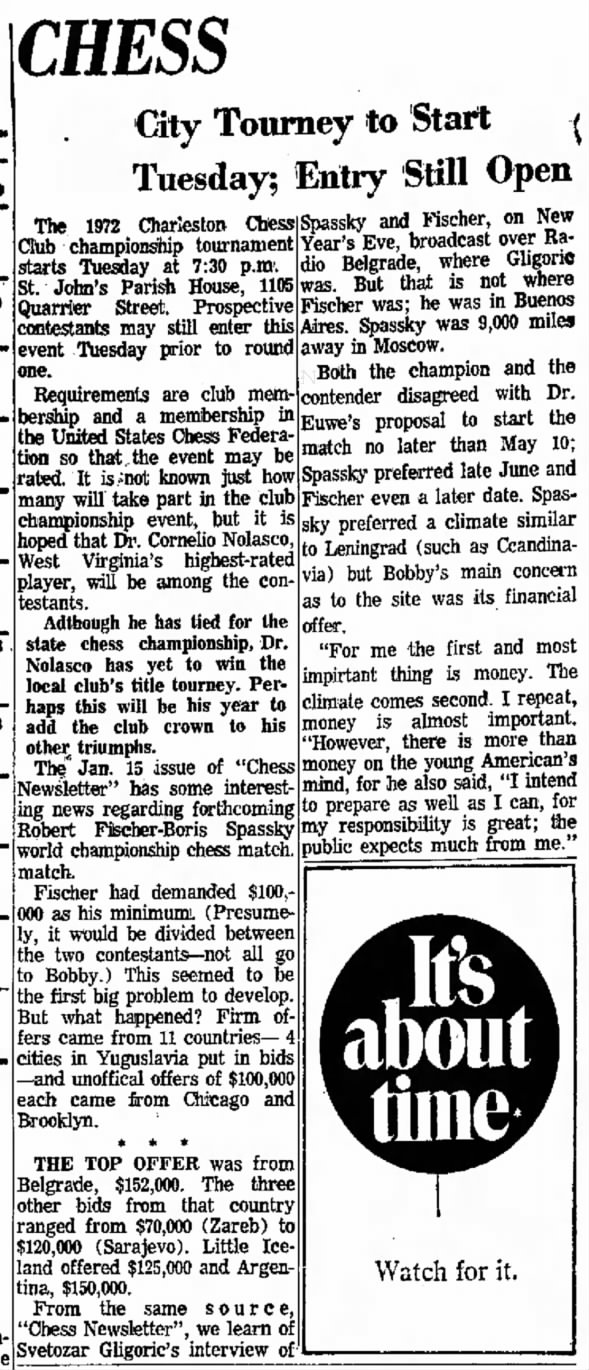 Chess Sun, Jan 23, 1972 – Page 32 · Sunday Gazette-Mail (Charleston, West Virginia) · Newspapers.com
Chess Sun, Jan 23, 1972 – Page 32 · Sunday Gazette-Mail (Charleston, West Virginia) · Newspapers.com
The Jan. 15 issue of “Chess Newsletter” has some interesting news regarding forthcoming Robert Fischer-Boris Spassky world championship chess match.
Fischer had demanded $100,000 as his minimum. (Presumably, it would be divided between the two contestants—not all go to Bobby.) This seems to be the first big problem to develop. But what happened? First offers came from 11 countries—4 cities in Yugoslavia put in bids—and unofficial offers of $100,000 each came from Chicago and Brooklyn.
THE TOP OFFER was from Belgrade, $152,000. The three other bids from that country ranged from $70,000 (Zagreb) to $120,000 (Sarajevo). Little Iceland offered $125,000 and Argentina, $100,000.
From the same source, “Chess Newsletter,” we learn of Svetozar Gligoric's interview of Spassky and Fischer, on New Year's Eve, broadcast over Radio Belgrade, where Gligoric was. But that is not where Fischer was; he was in Buenos Aires. Spassky was 9,000 miles away in Moscow.
Both the champion and the contender disagreed with Dr. Euwe's proposal to start the match no later than May 10; Spassky preferred late June and Fischer even a later date. Spassky preferred a climate similar to Leningrad (such as Scandinavia) but Bobby's main concern as to the site was its financial offer.
“For me the first and most important thing is money. The climate comes second. I repeat, money is most important.”
However, there is more than money on the young American's mind, for he also said, “I intend to prepare as well as I can, for my responsibility is great; the public expects much from me.”
< Prev Index Next >
 Chess by Isaac Kashdan Sun, Jan 16, 1972 – 118 · The Los Angeles Times (Los Angeles, California) · Newspapers.com
Chess by Isaac Kashdan Sun, Jan 16, 1972 – 118 · The Los Angeles Times (Los Angeles, California) · Newspapers.com
Chess by Isaac Kashdan Sunday, January 16, 1972 The Los Angeles Times Los Angeles, California Times Problem 4108 by L....
Posted by Bobby Fischer's True History on Saturday, December 19, 2020
Times Problem 4108 by L. Fontaine. White mates in two. An odd duel between the white pieces and the black pawns. The latter can do nothing right.
FEN 8/3NN2B/1Rppp3/K4p2/2pkp3/3p4/3QR3/3nB3 w - - 0 1
Key: Q-R6/Qh6
'til the world understands why Robert J. Fischer criticised the U.S./British and Russian military industry imperial alliance and their own Israeli Apartheid. Sarah Wilkinson explains: Tweets by swilkinsonbc |
 “What a sad story Fischer was,” typed a racist, pro-imperialist colonial troll who supports mega-corporation entities over human rights, police state policies & white supremacy. |
To which I replied: “Really? I think he [Bob Fischer] stood up to the broken system of corruption and raised awareness! Whether on the Palestinian/Israel-British-U.S. Imperial Apartheid scam, the Bush wars of ‘7 countries in 5 years,’ illegally, unconstitutionally which constituted mass xenocide or his run in with police brutality in Pasadena, California-- right here in the U.S., police run rampant over the Constitution of the U.S., on oath they swore to uphold, but when Americans don't know the law, and the cops either don't know or worse, “don't care” -- then I think that's pretty darn “sad”. I think Mr. Fischer held out and fought the good fight, steadfast til the day he died, and may he Rest In Peace. Educate yourself about U.S./State Laws -- https://www.youtube.com/@AuditTheAudit/videos After which the troll posted a string of profanities, confirming there was never any genuine sentiment of “compassion” for Mr. Fischer, rather an intent to inflict further defamatory remarks. |
This ongoing work is a tribute to the life and accomplishments of Robert “Bobby” Fischer who passionately loved and studied chess history. May his life continue to inspire many other future generations of chess enthusiasts and kibitzers, alike.
The photograph of Bobby Fischer (above) from the March 02, 1956 The Tampa Times was discovered by Sharon Mooney (Bobby Fischer Newspaper Archive editor) on February 01, 2018 while gathering research materials for this ongoing newspaper archive project. Along with lost games now being translated into Algebraic notation and extractions from over two centuries of newspapers, it is but one of the many lost treasures to be found in the pages of old newspapers since our social media presence was first established November 11, 2017.
